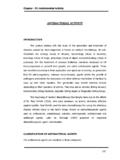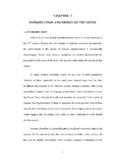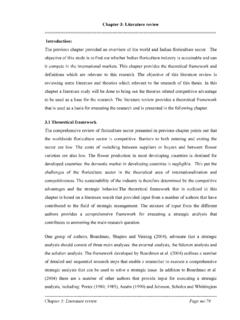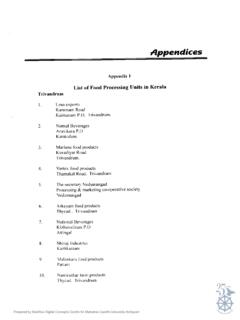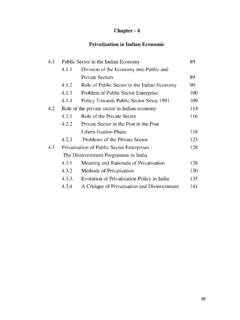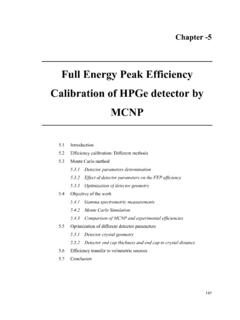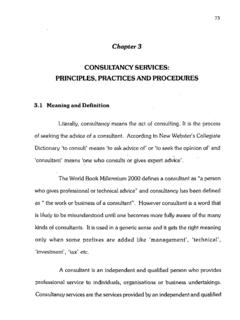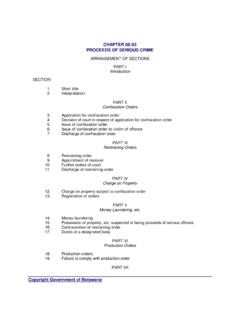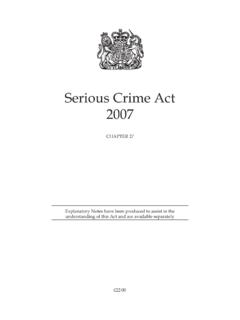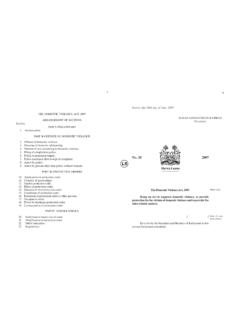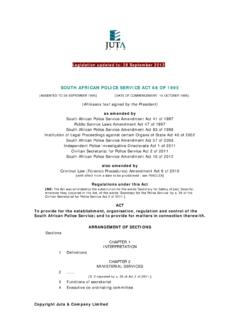Transcription of CHAPTER 4 CRIME AND THEORIES OF PUNISHMENT
1 117 CHAPTER 4 CRIME AND THEORIES OF PUNISHMENT CRIME In ordinary language, the term CRIME denotes an unlawful act punishable by the state. The term CRIME does not, in modern criminal law, have any simple and universally accepted definition,1 though statutory definitions have been provided for certain The most popular view is that CRIME is a category created by law ( something is a CRIME if applicable law says that it is). One proposed definition is that a CRIME , also called an offence or a criminal offence, is an act harmful not only to some individual, but also to the community or the state (a public wrong). Such acts are forbidden and punishable by law.
2 The idea that acts like murder, rape and theft are prohibited exists all around the world. What precisely is a criminal offence is defined by criminal law of each country. While many have a catalogue of crimes called the criminal code, in some common law countries no such comprehensive statute exists. The state (government) has the power to severely restrict one's liberty for committing a CRIME . Therefore, in modern societies, a criminal procedure must be adhered to during the investigation and trial. Only if found guilty, the offender may be sentenced to PUNISHMENT such as community sentence, imprisonment, life imprisonment or, in some jurisdictions, even death.
3 To be classified as a CRIME , the act of doing something bad (actus reus) must be usually accompanied by the intention to do something bad (mens rea), with certain exceptions (strict liability). While every CRIME violates the law, not every violation of the law counts as a CRIME . Breaches of private law (torts and breaches of contract) are not automatically punished by the state, but can be enforced through civil procedure. CLASSIFICATION AND CATEGORISATION The following classes of offences are used, or have been used, as legal terms of art: Offence against the person 3 Violent offence 4 Sexual offence Offence against property 1.
4 Http:/ / en. wikipedia. org/ w/ index. php?title=Template:Criminology_and_penol ogy& action=edit 2. Farmer, Lindsay. " CRIME , definitions of". In Cane and Conoghan (editors). The New Oxford Companion to Law. Oxford University ISBN 978 0 19 929054 3. Page 263. Google Books (http:/ / books. google. co. uk/ books?id=xjo5 AQAAIAAJ). 3. For example, by the Visiting Forces Act 1952 4. For example, by section 31(1) of the Criminal Justice Act 1991, and by the Criminal Justice Act 2003 118 Researchers and commentators have classified crimes into the following categories, in addition to those above: Forgery, personation and cheating 5 Firearms and offensive weapons 6 Offences against the State/offences against the Crown and Government32political offences 7 Harmful or dangerous drugs 8 Offences against religion and public worship 9 Offences against public justice 10 offences against the administration of public justice 11 Public order offence 12 Commerce, financial markets and insolvency 13 Offences against public morals and public policy 14 Motor vehicle offences 15 Conspiracy.
5 Incitement and attempt to commit CRIME 16 Inchoate offence Juvenile delinquency17 CATEGORISATION BY PENALTY One can categorise crimes depending on the related PUNISHMENT , with sentencing tariffs prescribed in line with the perceived seriousness of the offence. Thus fines and noncustodial sentences may address the crimes seen as least serious, with lengthy imprisonment or (in some jurisdictions) capital PUNISHMENT reserved for the most serious. COMMON LAW Under the common law of England, crimes were classified as treason, felony or misdemeanour, with treason sometimes being included with the felonies. This system was based on the perceived seriousness of the offence.
6 It is still used in the 5 Archbold Criminal Pleading, Evidence and Practice, 1999, CHAPTER 22 6 Archbold Criminal Pleading, Evidence and Practice, 1999, CHAPTER 24 7 Archbold Criminal Pleading, Evidence and Practice, 1999, CHAPTER 25 8 Card, Cross and Jones: Criminal Law, 12th ed, 1992, CHAPTER 17 9 Archbold Criminal Pleading, Evidence and Practice, 1999, CHAPTER 26 10 Archbold Criminal Pleading, Evidence and Practice, 1999, CHAPTER 27 11 Archbold Criminal Pleading, Evidence and Practice, 1999, CHAPTER 28 12 Card, Cross and Jones: Criminal Law, 12th ed, 1992, CHAPTER 16 13 Archbold Criminal Pleading, Evidence and Practice, 1999, CHAPTER 29 14 Archbold Criminal Pleading, Evidence and Practice, 1999, CHAPTER 30 15 Archbold Criminal Pleading, Evidence and Practice, 1999, CHAPTER 31 16 Archbold Criminal Pleading, Evidence and Practice, 1999, CHAPTER 32 17 Archbold Criminal Pleading, Evidence and Practice, 1999, CHAPTER 33 119 United States but the distinction between felony and misdemeanour is abolished in England and Wales and Northern Ireland.
7 CLASSIFICATION BY MODEOF TRIAL The following classes of offence are based on mode of trial: Indictable-only offence Indictable offence Hybrid offence, aka either-way offence in England and Wales Summary offence, aka infraction in the US CLASSIFICATION BY ORIGIN In common law countries, crimes may be categorised into common law offences and statutory offences. In the US, Australia and Canada (in particular), they are divided into federal crimes and under state crimes. OTHER CLASSIFICATIONS Arrestable offence U S CLASSIFICATION In the United States since 1930, the FBI has tabulated Uniform CRIME Reports (UCR) annually from CRIME data submitted by law enforcement agencies across the United States.
8 Officials compile this data at the city, county, and state levels into the UCR. They classify violations of laws based on common law as Part I (index) crimes in UCR data. These are further categorised as violent or property crimes. Part I violent crimes include murder and criminal homicide (voluntary manslaughter), forcible rape, aggravated assault, and robbery; while Part I property crimes include burglary, arson, larceny/theft, and motor-vehicle theft. All other crimes count come under Part II. For convenience, such lists usually include infractions although, in the , they may come into the sphere not of the criminal law, but rather of the civil law. Compare tortfeasance.
9 Booking arrests require detention for a time-frame ranging 1 to 24 hours. DEFINITION a) ENGLAND AND WALES Whether a given act or omission constitutes a CRIME does not depend on the nature of that act or omission. It depends on the nature of the legal consequences that may follow An act or omission is a CRIME if it is capable of being followed by 18 Seaman v Burley [1896] 2 QB, per Lord Esher MR at 346. 120 what are called criminal proceedings. 19, 20 1871, and applied21 for the purposes of section 10 of the Prevention of CRIME Act 190 The expression " CRIME " means, in England and Ireland, any felony or the offence of uttering false or counterfeit coin, or of possessing counterfeit gold or silver coin, or the offence of obtaining goods or money by false pretences, or the offence of conspiracy to defraud, or any misdemeanour under the fifty-eighth section of the Larceny Act, 1861.
10 OTHER DEFINITIONS Legislatures can pass laws (called mala prohibita) that define crimes against social norms. These laws vary from time to time and from place to place: note variations in gambling laws, for example, and the prohibition or encouragement of duelling in history. Other crimes, called mala in se, count as outlawed in almost all societies,(murder, theft and rape, for example).English criminal law and the related criminal law of Commonwealth countries can define offences that the court salone have developed over the years, without any actual legislation: common law offences. The courts used the concept of malum in se to develop various common law ETYMOLOGY The word CRIME is derived from the Latin root cern , meaning "I decide, I give judgment".
